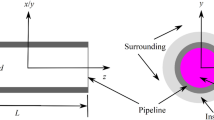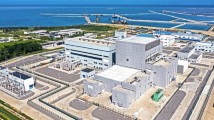A comparative analysis is performed of emergency cool-down systems of water-cooled reactors, using passive heat-removal systems. The use of such a system reduces the likelihood of serious accidents with core damage at NPP but the capital investment and associated operating costs are higher. Auxiliary expenditures on maintaining this system in a standby mode are also required. A scheme combining active and passive cool-down systems is proposed owing to the rejection of air heat-exchangers-condensers of the passive heat-removal system and the installation of an auxiliary low-capacity steam turbogenerator is proposed. A comparative technical-economic analysis of the proposed combined cool-down system and an air passive heat-removal system is performed. The calculations show that at comparable safety levels such a system makes it possible to reduce capital and total operating expenses for NPP located in all climatic belts.
Similar content being viewed by others
References
M. M. Grigor’ev, A. A. Plakseev, and N. A. Podporina, “Capacity characteristics of a passive heat removal system in a nuclear power plant with VVER-1000 as a function of the parameters of the medium in the steam generator,” in: 6th Int. Seminar on Horizontal Steam Generators, Podolsk, March 22–24, 2004, pp. 1–4.
I. I. Sviridenko, V. A. Timofeev, and D. V. Shevelev, “Investigation of the characteristics of a passive heat protection of a final absorber PHRS of a reactor unit with VVER-1000,” Visn. SevDTU, Vid. SevNTU, Sevastopol (2009), No. 97, pp. 69–74.
A. S. Korshunov and G. S. Taranov, “NVA ESP: validation of passive safety systems,” Byull. Rosenergoatoma, No. 6, 12–17 (2008).
O. O. Mil’man, A. V. Ptakhin, A. V. Kondrat’ev, et al., “Startup of air-condensation units and dry cooling towers at negative cooling-air temperatures,” Teploenergetika, No. 5, 24–30 (2016).
Construction Climatology: Ref. Book on SNiP 23-01–9, NIISF RAASN, Moscow (2006).
M. Ya. Kordon, V. N. Simakin, and I. D. Goreshnik, Heat Engineering, Penza (2005).
R. Z. Aminov, V. E. Yugin, and D. A. Markelov, “Backup of internal needs of NPP under blackout conditions based on a hydrogen cycle,” At. Energ., 118, No. 1, 261–266 (2015).
Author information
Authors and Affiliations
Additional information
Translated from Atomnaya Energiya, Vol. 121, No. 6, pp. 316–322, December, 2016.
Rights and permissions
About this article
Cite this article
Aminov, R.Z., Egorov, A.N. Comparison and Analysis of Residual Heat Removal Systems of Reactors in Station Blackout Accidents. At Energy 121, 402–408 (2017). https://doi.org/10.1007/s10512-017-0219-y
Received:
Published:
Issue Date:
DOI: https://doi.org/10.1007/s10512-017-0219-y




